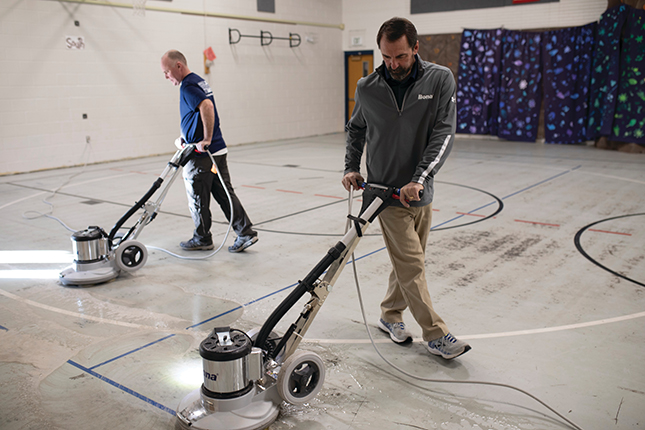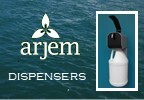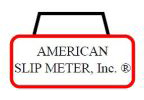Companies in nearly every industry are weathering a tough economic climate in 2024 – from inflation to interest rates to increasing minimum wages. Add the continued labor shortage and rising insurance rates to the mix, and it’s easy to see why facilities continue to cut budgets.

There is a silver lining in this economic roller coaster, in fact, many companies are not just surviving but thriving. Facilities are leveraging new innovations and tools to streamline cleaning, maintenance, care and upkeep of buildings. For example, new innovations in hard surface flooring treatments allow an increase in productivity and reduction of labor costs, all while greatly improving the overall maintenance process. Additionally, renewal is a more sustainable option when compared to flooring replacement all while creating a modern, gorgeous floor aesthetic.
High quality flooring at a sensible price point
Renewing hard surface flooring offers a range of economic benefits over the life of the floor. Facilities managers must build downtime and the construction costs of time, labor and materials into the budget, regardless of renewal or replacement. However, the renewal process can typically be completed in a matter of hours, rather than days or weeks. Since resilient flooring renewal systems are applied over existing flooring surfaces, facilities reduce the labor cost of tearing out and installing a floor while also minimizing costs associated with out-of-service downtime for the building.
The resilient renewal system is efficient to implement, and with proper training, many in-house maintenance teams execute the entire process – another economic benefit. Resilient renewal systems can also be applied in sections, allowing facilities to prioritize based on budget and workflow of the building.
For example, Sunnyside Unified School District in Arizona saved over $40,000 by having the floors renovated versus installing a full floor replacement. The district achieved an aesthetically-pleasing, cohesive design able to withstand heavy foot traffic from students and staff. The district is planning for additional flooring renewal projects for its schools.
“Another principal in our school district has seen pictures of this project and is anxiously waiting for the opportunity to have their floors upgraded,” noted Manuel Portillo, maintenance custodian supervisor for Sunnyside.
Centennial Hills Hospital in Las Vegas realized 75% cost savings by renovating a labor and delivery room flooring instead of replacing it. Labor and material expenses for replacement would be high, and also cost three days of downtime. Instead, Centennial Hills utilized a flooring renewal system to revitalize the surface in 18 hours.

Reduce maintenance over the lifetime of the floor
One of the greatest benefits to a resilient flooring renewal system is the new and improved maintenance process. The resilient renewal process eliminates the need to ever polish the floor again, also eliminating the need to close large sections of the facility for stripping and polishing, or pay maintenance teams overtime to work outside of operating hours.
Reduced flooring maintenance – in addition to being a continual cost saver – means facility managers can keep daily operations on schedule by implementing an efficient floor renewal and maintenance system.
When Havasu Regional Medical Center in Arizona needed an upgrade to its old, worn resilient flooring, the facility sought a cost-effective renewal solution to revitalize its flooring and keep it compliant with safety standards. Since the renewal process eliminates the recurring cost and resource of polishing the floor after installation, Havasu Regional Medical Center was able to turn rooms more quickly, freeing up those labor resources to work on other important work.

Respect the environment
Sustainability is becoming more important to facilities and building owners. The flooring market offers a variety of options so it’s important to carefully specify and source the right materials with sustainability, as well as efficiency and budget, in mind.
A study by IVL Swedish Environmental Research Institute (IVL) found that renewing resilient floor surfaces can offer up to 92% reduction in carbon footprint and 95% savings in energy resources, versus replacing. Renovating a wood floor offers a 78% carbon footprint reducing and similar energy savings as resilient. Today, even the most worn, dilapidated hard surface floors can be sustainably transformed.
Flooring renewal creates a long-lasting surface, utilizes existing materials, keeps trash out of the landfill and eliminates the carbon footprint and toxic fumes created by new products and materials.
When Schill Dental Clinic’s worn PVC flooring needed rejuvenating, the Slovakia-based Schill team sought a durable surface that would protect against contaminants and withstand repeated cleanings and disinfectant use. Schill chose a low VOC waterborne resilient renewal solution. The total project prevented nearly 400 lbs of carbon dioxide from being released into the environment.
When evaluating environmentally-safe chemistries, facilities teams should seek manufacturers that have achieved GREENGUARD Certification for their products – meaning the chemistry is scientifically proven to meet some of the world’s most stringent third-party chemical emissions standards, and helps reduce indoor air pollution. Volatile organic compounds (VOCs) are common in interior environments, and indoor levels can be two to a thousand times higher than outdoors, according to studies by the U.S. Environmental Protection Agency.
These innovations in floor renewal offer facilities an effective avenue for maximizing already tight budgets. Best of all the results are durable, beautiful and take environmental impact into account.
About the author: Dave Darche is the national market manager of adhesives/A&D for Bona US and has been in the flooring industry for more than 35 years. He currently serves on the National Wood Flooring Association Architect & Design Committee and is an NWFA Certified Inspector. He can be reached at Dave.Darche@bona.com.
|










